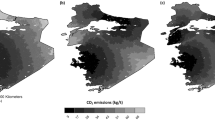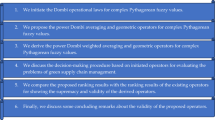Abstract
The green supplier selection (GSS) problem is a well-known strategy to outsource with respect to environmental protection. Although different applications of GSS have been proposed in the literature, the fuzzy five-objective GSS model has not been studied yet. This paper develops a multi-objective fuzzy linear programming model for a GSS problem, including 17 criteria, formed into 5 clusters while a hybrid fuzzy multi objective decision making (MODM) is employed to solve it. The aim of this paper is to select the best set of suppliers regarding optimal allocation of order quantities while demand and supplier’s capacity are restricted. In the proposed hybrid solution algorithm, fuzzy decision making trial and evaluation laboratory approach is used to understand the interrelation among criteria, and fuzzy analytical network process (ANP) provides the criteria weights with respect to their dependencies. Then, a hybrid of fuzzy ANP and fuzzy multi-objective linear programming presents optimal order allocation among the selected suppliers, verified and compared with two other methods. Finally, the conclusion and future research are presented.




Similar content being viewed by others
References
Akarte, M., Surendra, N., Ravi, B., & Rangaraj, N. (2001). Web based casting supplier evaluation using analytical hierarchy process. Journal of the Operational Research Society, 52, 511–522.
Amid, A., Ghodsypour, S. H., & O’Brien, C. (2011). A weighted max–min model for fuzzy multi-objective supplier selection in a supply chain. International Journal of Production Economics, 131(1), 139–145.
Amin, S. H., & Zhang, G. (2012). An integrated model for closed-loop supply chain configuration and supplier selection: Multi-objective approach. Expert Systems with Applications, 39(8), 6782–6791.
Arikan, F. (2013). A fuzzy solution approach for multi objective supplier selection. Expert Systems with Applications, 40(3), 947–952.
Ayağ, Z. (2014). An integrated approach to concept evaluation in a new product development. Journal of Intelligent Manufacturing. doi:10.1007/s10845-014-0930-7.
Barua, A., Mudunuri, L. S., & Kosheleva, O. (2014). Why trapezoidal and triangular membership functions work so well: Towards a theoretical explanation. Journal of Uncertain Systems, 8(3), 164–168.
Büyüközkan, G., & Çifçi, G. (2012). A novel hybrid MCDM approach based on fuzzy DEMATEL, fuzzy ANP and fuzzy TOPSIS to evaluate green suppliers. Expert Systems with Applications, 39(3), 3000–3011.
Chai, J., Liu, J. N., & Ngai, E. W. (2013). Application of decision-making techniques in supplier selection: A systematic review of literature. Expert Systems with Applications, 40(10), 3872–3885.
Choudhary, D., & Shankar, R. (2014). A goal programming model for joint decision making of inventory lot-size, supplier selection and carrier selection. Computers & Industrial Engineering, 71, 1–9.
De Boer, L., Labro, E., & Morlacchi, P. (2001). A review of methods supporting supplier selection. European Journal of Purchasing & Supply Management, 7(2), 75–89.
Dickson, G. W. (1966). An analysis of vendor selection systems and decisions. Journal of purchasing, 2(1), 5–17.
Dou, Y., Zhu, Q., & Sarkis, J. (2014). Evaluating green supplier development programs with a grey-analytical network process-based methodology. European Journal of Operational Research, 233(2), 420–431.
Enarsson, L. (1998). Evaluation of suppliers: How to consider the environment. International Journal of Physical Distribution & Logistics Management, 28(1), 5–17.
Esfandiari, N., & Seifbarghy, M. (2013). Modeling a stochastic multi-objective supplier quota allocation problem with price-dependent ordering. Applied Mathematical Modelling, 37(8), 5790–5800.
Ghodsypour, S. H., & O’brien, C. (1998). A decision support system for supplier selection using an integrated analytic hierarchy process and linear programming. International Journal of Production Economics, 56, 199–212.
Govindan, K., Rajendran, S., Sarkis, J., & Murugesan, P. (2013). Multi criteria decision making approaches for green supplier evaluation and selection: A literature review. Journal of Cleaner Production. doi:10.1016/j.jclepro.2013.06.046.
Guo, C., & Li, X. (2014). A multi-echelon inventory system with supplier selection and order allocation under stochastic demand. International Journal of Production Economics, 151, 37–47.
Gürbüz, T., Alptekin, S. E., & Işıklar Alptekin, G. (2012). A hybrid MCDM methodology for ERP selection problem with interacting criteria. Decision Support Systems, 54(1), 206–214.
Hammami, R., Temponi, C., & Frein, Y. (2014). A scenario-based stochastic model for supplier selection in global context with multiple buyers, currency fluctuation uncertainties, and price discounts. European Journal of Operational Research, 233(1), 159–170.
Ho, W., Xu, X., & Dey, P. K. (2010). Multi-criteria decision making approaches for supplier evaluation and selection: A literature review. European Journal of Operational Research, 202(1), 16–24.
Hsu, C.-W., Kuo, T.-C., Chen, S.-H., & Hu, A. H. (2013). Using DEMATEL to develop a carbon management model of supplier selection in green supply chain management. Journal of Cleaner Production, 56, 164–172.
Igarashi, M., de Boer, L., & Fet, A. M. (2013). What is required for greener supplier selection? A literature review and conceptual model development. Journal of Purchasing and Supply Management, 19(4), 247–263.
Jadidi, O., Zolfaghari, S., & Cavalieri, S. (2014). A new normalized goal programming model for multi-objective problems: A case of supplier selection and order allocation. International Journal of Production Economics, 148, 158–165.
Jain, V., Kundu, A., Chan, F. S., & Patel, M. (2013). A Chaotic Bee Colony approach for supplier selection-order allocation with different discounting policies in a coopetitive multi-echelon supply chain. Journal of Intelligent Manufacturing. doi:10.1007/s10845-013-0845-8.
Kang, H.-Y., Lee, A. I., & Yang, C. Y. (2012). A fuzzy ANP model for supplier selection as applied to IC packaging. Journal of Intelligent Manufacturing, 23(5), 1477–1488.
Kannan, D., Govindan, K., & Rajendran, S. (2014a). Fuzzy Axiomatic Design approach based green supplier selection: A case study from Singapore. Journal of Cleaner Production. doi:10.1016/j.jclepro.2013.12.076.
Kannan, D., Jabbour, A. B. L. D. S., & Jabbour, C. J. C. (2014b). Selecting green suppliers based on GSCM practices: Using fuzzy TOPSIS applied to a Brazilian electronics company. European Journal of Operational Research, 233(2), 432–447.
Kannan, D., Khodaverdi, R., Olfat, L., Jafarian, A., & Diabat, A. (2013). Integrated fuzzy multi criteria decision making method and multi-objective programming approach for supplier selection and order allocation in a green supply chain. Journal of Cleaner Production, 47, 355–367.
Kumru, M. & Kumru, P. (2014). A fuzzy ANP model for the selection of 3D coordinate-measuring machine. Journal of Intelligent Manufacturing. doi:10.1007/s10845-014-0882-y.
Kuo, R. J., Wang, Y. C., & Tien, F. C. (2010). Integration of artificial neural network and MADA methods for green supplier selection. Journal of Cleaner Production, 18(12), 1161–1170.
Li, R.-J. (1999). Fuzzy method in group decision making. Computers & Mathematics with Applications, 38(1), 91–101.
Lin, C.-C. (2004). A weighted max–min model for fuzzy goal programming. Fuzzy Sets and Systems, 142(3), 407–420.
Lin, R.-H. (2012). An integrated model for supplier selection under a fuzzy situation. International Journal of Production Economics, 138(1), 55–61.
Liou, J. J. H., Chuang, Y.-C., & Tzeng, G.-H. (2014). A fuzzy integral-based model for supplier evaluation and improvement. Information Sciences, 266, 199–217.
Lloyd, M. (1994). How green are my suppliers? Buying environmental risk. Purchasing and Supply Management, 1(4), 36–39.
MacNeill, F. M., & THRO, E. A. (1994). Fuzzy logic: A practical approach. New York: Academic Press.
Nazari-Shirkouhi, S., Shakouri, H., Javadi, B., & Keramati, A. (2013). Supplier selection and order allocation problem using a two-phase fuzzy multi-objective linear programming. Applied Mathematical Modelling, 37(22), 9308–9323.
Opricovic, S., & Tzeng, G.-H. (2003). Defuzzification within a multicriteria decision model. International Journal of Uncertainty, Fuzziness and Knowledge-Based Systems, 11(05), 635–652.
Ozaki, T., Lo, M.-C., Kinoshita, E., & Tzeng, G.-H. (2012). Decision-making for the best selection of suppliers by using minor ANP. Journal of Intelligent Manufacturing, 23(6), 2171–2178.
Pang, B., & Bai, S. (2013). An integrated fuzzy synthetic evaluation approach for supplier selection based on analytic network process. Journal of Intelligent Manufacturing, 24(1), 163–174.
Razmi, J., Rafiei, H., & Hashemi, M. (2009). Designing a decision support system to evaluate and select suppliers using fuzzy analytic network process. Computers & Industrial Engineering, 57(4), 1282–1290.
Rouyendegh, B. D., & Saputro, T. E. (2014). Supplier selection using integrated Fuzzy TOPSIS and MCGP: A case study. Procedia-Social and Behavioral Sciences, 116, 3957–3970.
Saaty, T. L. (1996). Decision making with dependence and feedback: The analytic network process. Pittsburgh, PA: RWS.
Sarkis, J., Meade, L. M., & Presley, A. R. (2012). Incorporating sustainability into contractor evaluation and team formation in the built environment. Journal of Cleaner Production, 31, 40–53.
Sharma, S., & Balan, S. (2013). An integrative supplier selection model using Taguchi loss function, TOPSIS and multi criteria goal programming. Journal of Intelligent Manufacturing, 24(6), 1123–1130.
Shaw, K., Shankar, R., Yadav, S. S., & Thakur, L. S. (2012). Supplier selection using fuzzy AHP and fuzzy multi-objective linear programming for developing low carbon supply chain. Expert Systems with Applications, 39(9), 8182–8192.
Shen, L., Olfat, L., Govindan, K., Khodaverdi, R., & Diabat, A. (2013). A fuzzy multi criteria approach for evaluating green supplier’s performance in green supply chain with linguistic preferences. Resources, Conservation and Recycling, 74, 170–179.
Shidpour, H., Shahrokhi, M., & Bernard, A. (2013). A multi-objective programming approach, integrated into the TOPSIS method, in order to optimize product design: In three-dimensional concurrent engineering. Computers & Industrial Engineering, 64(4), 875–885.
Singh, A. (2014). Supplier evaluation and demand allocation among suppliers in a supply chain. Journal of Purchasing and Supply Management, 20(3), 167–176.
Theißen, S., & Spinler, S. (2014). Strategic analysis of manufacturer–supplier partnerships: An ANP model for collaborative CO\(_2\) reduction management. European Journal of Operational Research, 233(2), 383–397.
Tiwari, R., Dharmar, S., & Rao, J. (1987). Fuzzy goal programming—An additive model. Fuzzy Sets and Systems, 24(1), 27–34.
Tzeng, G.-H., & Huang, J.-J. (2011). Multiple attribute decision making: Methods and applications. Boca Raton: CRC Press.
Wang, C.-H., & Chen, J.-N. (2012). Using quality function deployment for collaborative product design and optimal selection of module mix. Computers & Industrial Engineering, 63(4), 1030–1037.
Wang, C.-H., & Wu, H.-S. (2014). A novel framework to evaluate programmable logic controllers: a fuzzy MCDM perspective. Journal of Intelligent Manufacturing. doi:10.1007/s10845-013-0863-6.
Wang, T.-Y., & Yang, Y.-H. (2009). A fuzzy model for supplier selection in quantity discount environments. Expert Systems with Applications, 36(10), 12179–12187.
Ware, N. R., Singh, S., & Banwet, D. (2014). A mixed-integer non-linear program to model dynamic supplier selection problem. Expert Systems with Applications, 41(2), 671–678.
Weber, C. A., Current, J. R., & Benton, W. (1991). Vendor selection criteria and methods. European Journal of Operational Research, 50(1), 2–18.
Wu, W.-W., & Lee, Y.-T. (2007). Developing global managers’ competencies using the fuzzy DEMATEL method. Expert Systems with Applications, 32(2), 499–507.
Xiao, Z., Chen, W., & Li, L. (2012). An integrated FCM and fuzzy soft set for supplier selection problem based on risk evaluation. Applied Mathematical Modelling, 36(4), 1444–1454.
Yang, P. C., Wee, H. M., Pai, S., & Tseng, Y. F. (2011). Solving a stochastic demand multi-product supplier selection model with service level and budget constraints using Genetic Algorithm. Expert Systems with Applications, 38(12), 14773–14777.
Zimmermann, H.-J. (1978). Fuzzy programming and linear programming with several objective functions. Fuzzy Sets and Systems, 1(1), 45–55.
Zimmermann, H. J. (1993). Fuzzy set theory and its applications. New York: Springer.
Zouggari, A., & Benyoucef, L. (2012). Simulation based fuzzy TOPSIS approach for group multi-criteria supplier selection problem. Engineering Applications of Artificial Intelligence, 25(3), 507–519.
Acknowledgments
The authors are thankful for constructive comments of the anonymous reviewers. Taking care of the comments certainly improved the presentation.
Author information
Authors and Affiliations
Corresponding author
Rights and permissions
About this article
Cite this article
Bakeshlou, E.A., Khamseh, A.A., Asl, M.A.G. et al. Evaluating a green supplier selection problem using a hybrid MODM algorithm. J Intell Manuf 28, 913–927 (2017). https://doi.org/10.1007/s10845-014-1028-y
Received:
Accepted:
Published:
Issue Date:
DOI: https://doi.org/10.1007/s10845-014-1028-y




